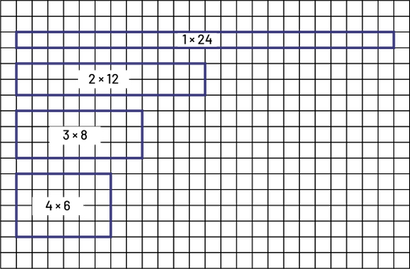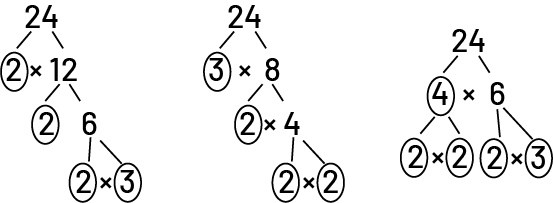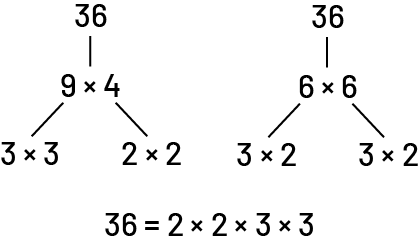B2.6 Represent composite numbers as a product of their prime factors, including through the use of factor trees.
Skill: Representing Composite Numbers as a Multiplication of Prime Factors
Just as numbers can be composed and decomposed by addition and subtraction, they can be composed and decomposed by multiplication and division (factoring). The factors of a number describe the ways in which it can be broken down into equal parts by multiplication and division.
Source: translated from Ontario Curriculum, Mathematics Curriculum, Grades 1-8, 2020, Ontario Ministry of Education.
A composite number is a whole number greater than 1 that has more than two factors. For example, 14 is a composite number because it has four factors: 1, 2, 7 and 14.
In contrast, a prime number is a whole number greater than 1 that has exactly two unique factors (for example, 23 is a prime number because it has only 1 and itself as factors). All whole numbers greater than 1 are therefore either composite numbers or prime numbers. As for the numbers 0 and 1, they are by definition neither prime nor composite.
Students can establish that all primes except 2 are odd, but that not all odd numbers are necessarily prime numbers (for example, 9 is an odd number that is composite).
The ability to recognize that a number is prime or composite can facilitate problem solving.
Example
Students are asked to create a rectangle with dimensions that are integer values.
What are the possible dimensions of the rectangle if its area is 23 cm2? 11 cm2? 24 cm2?
Recognizing that 23 and 11 are prime numbers, students can justify that in each of these two cases there is only one set of possible dimensions (for example., a rectangle of 1 cm by 11 cm and a rectangle of 1 cm by 23 cm).

\(11\; = \;1\; \times \;11\)
\(23\; = \;1\; \times \;23\)
Source: translated from Guide d’enseignement efficace des mathématiques de la 4e à la 6e année, Numération et sens du nombre, Fascicule 1, Nombres naturels, p. 59.
A rectangle with an area of 24 cm2 can have many different dimensions that are based on the factors of 24.


We can also show that 24 is a composite number by using factor trees to arrive at its prime factors.

\(24\; = \;2\; \times \;2\; \times \;2\; \times \;3\)
A number can be decomposed into factors. Factor trees help to decompose a number into all its factors.
The factors of a number can assist with mental calculations. For example, it might be difficult to mentally calculate 36 × 4, but seeing the product as 4 × 3 × 3 × 4 means that by using associative property, the factors can also produce 12 × 12, a known fact.

Source: Ontario Curriculum, Mathematics, Grades 1-8, 2020, Ontario Ministry of Education.
Knowledge: Composite Numbers
A number that has factors in addition to itself and 1. For example, the number 8 has four factors: 1, 2, 4, and 8.
Source: Ontario Curriculum, Mathematics Curriculum, Grades 1-8, 2020, Ontario Ministry of Education.
Knowledge: Prime Numbers
A whole number greater than 1 that has only two factors, itself and 1. For example, the only factors of 7 are 7 and 1.
Source: Ontario Curriculum, Mathematics Curriculum, Grades 1-8, 2020, Ontario Ministry of Education.
Knowledge: Factor Tree
A diagram drawn to find the factors of a natural number. The chosen number is drawn with two branches leading to any two of its factors. Each of these factors will then be drawn with two branches leading to two of their factors. This process continues until no more factors can be found.

Source: Ontario Curriculum, Mathematics Curriculum, Grades 1-8, 2020, Ontario Ministry of Education.
